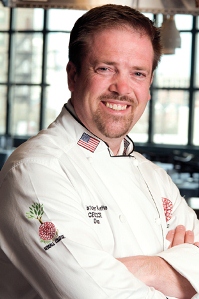Green Tomato: Waste Not, Want Not
31 August 2011
 Many free materials are readily at your disposal to teach the “3 Rs” of handling excess prepared food, food scraps and used oil more sustainably.
Many free materials are readily at your disposal to teach the “3 Rs” of handling excess prepared food, food scraps and used oil more sustainably.
By Christopher Koetke, CEC, CCE
Many of us grew up with that wise adage, but it’s even more true today. In sustainability, when we talk about waste, the focus is usually on recycling and composting—basically, how to divert our waste from the landfill. However, that’s not the most sustainable solution. The U.S. Department of Agriculture (USDA) and the U.S. Environmental Protection Agency (EPA) have developed a program that advocates use of its “Food Waste Recovery Hierarchy.” We often talk about the “3 Rs”—reduce, reuse or recycle—and this program prioritizes those options.
Reduce. The most sustainable waste option is to not create it in the first place. According to Jonathan Bloom, author of American Wasteland: How America Throws Away Nearly Half of Its Food (and What We Can Do About It), Americans routinely toss out 40% of all the food produced each year. And it’s important to keep in mind that along with the wasted food, we also wasted the water, energy and other resources used to produce, harvest and transport it to our kitchens.
Exploring how to reduce waste and the effect it can have on a foodservice operation offers a fantastic opportunity for a classroom exercise. The EPA has developed materials that you and your students can use to do a waste audit in your operation. Start by tracking your waste with the EPA waste logs. Then take it a step further with the food waste management cost calculator to estimate the cost benefits employing the use of alternatives including source reduction, donation, composting and recycling of yellow grease.
Reuse. Every operation has food at the end of the day that never makes it to consumers. At the same time, the EPA estimates there are 36 million Americans who are food insecure—basically, they’re not sure where their next meal is coming from. This includes seniors who are forced to choose between food and medicine, parents who go hungry so they can feed their children, and working families who regularly must decide whether to pay rent and utilities or put food on the table.
Community food banks and kitchens, along with organizations such as Meals on Wheels, are the conduit to those people who need it. Often such organizations are more than happy to pick up the food at your establishment so there’s very little effort needed to make such donations. And the federal Good Samaritan law protects organizations from liability surrounding their donations. Setting up such a system within your culinary program would be a tremendous learning experience for your students while providing an important lesson in the value of community service.
And for food scraps not suitable for human consumption, consider working with local farmers who might be able to use them for animal feed. This can be a little more difficult because there are regulations about how that food must be treated, but there are also companies that are in the business of converting food discards into animal and pet food. Similarly, liquid fats and solid meat products can be rendered and converted into products from animal food to soap and cosmetics; rendering companies regularly provide storage barrels and free pick-up service.
Another option that we’re hearing a great deal about in our business is the conversion of fats, oils and grease into biodiesel. The renowned Scoma’s restaurant on San Francisco’s Fisherman’s Wharf collects its used vegetable oil, filters it and uses some of it to power its company truck—the Vegiemobile. The remainder is donated to the Golden Gate Bridge district to power its maintenance trucks and equipment.
Recycle. Once the other, more useful avenues are exhausted, then recycling or composting is your best option. Sources for information on that are plentiful. Here are a few: 1) U.S. Composting Council; 2) Recycling Revolution; and 3) Earth 911.
So the next time you’re staring at good food that will go to waste, think about your options and “reduce, reuse and recycle,” in that order. For more information on the EPA’s “Waste Not, Want Not” program, go to http://www.epa.gov/wastes/conserve/materials/organics/pubs/wast_not.pdf.
Christopher Koetke, CEC, CCE, is executive director of the Kendall College School of Culinary Arts and vice president of Laureate International Universities Center of Excellence in Culinary Arts. Kendall College sponsors the annual CAFÉ/Kendall College Green Award.
Additional Info
- CAFÉ Talks Podcast Lesson Plan: 1



